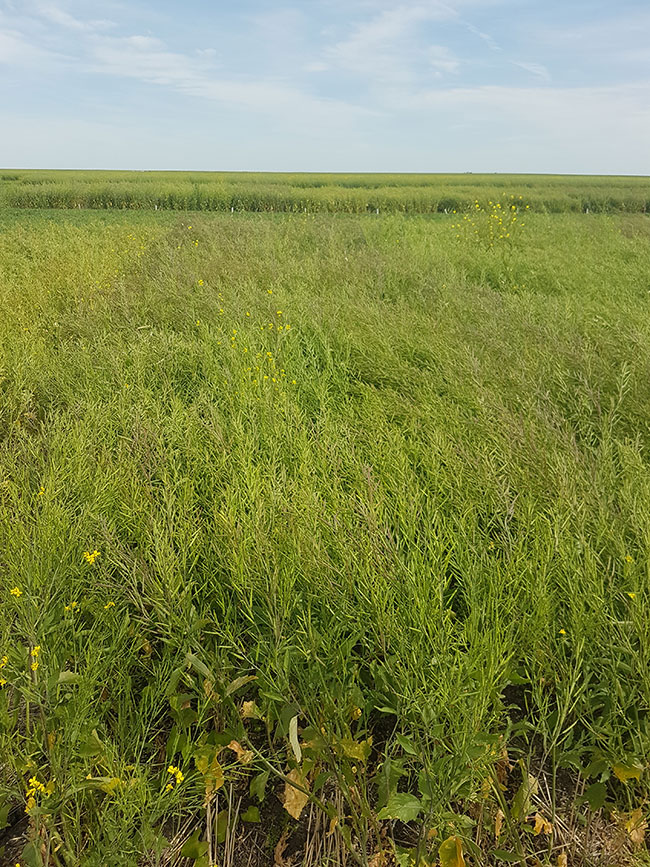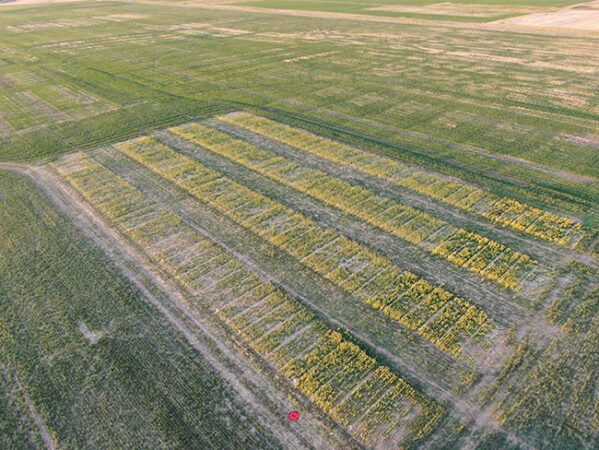
Features
Research
Hybrid mustard out-performs open pollinated varieties
Research looked at seeding and nitrogen rates.
December 13, 2023 By Bruce Barker
 With a seeding rate of 10 seeds/sq. ft., hybrid mustard was able to compensate for lower plant populations with more vigorous growth.
Photos courtesy of AMBER WALL.
With a seeding rate of 10 seeds/sq. ft., hybrid mustard was able to compensate for lower plant populations with more vigorous growth.
Photos courtesy of AMBER WALL. Hybrid mustard is heating up for Prairie growers. With higher yield potential than open-pollinated varieties, hybrids could boost mustard production and returns, just as they did with canola. Recent research aimed to determine if there were differences in seeding and nitrogen rates between them.
“When you look at canola, when hybrids came out, growers were able to reduce seeding rates without sacrificing yield. And with the higher yield potential, hybrid canola responded better to intensive management,” says Cory Jacob, provincial oilseed specialist with the Saskatchewan Ministry of Agriculture in Regina. “We wanted to see if hybrid mustard would respond differently to inputs like seeding rate and nitrogen fertility than open-pollinated varieties.”
The research spanned three years from 2020 through 2022 at the Wheatland Conservation Area (WCA) in Swift Current, Sask., the Indian Head Agricultural Research Foundation (IHARF) in Indian Head, Sask., and the South East Research Farm (SERF) in Redvers, Sask. It was funded by the ministry’s Strategic Field Program and consisted of two components: a nitrogen (N) rate trial and a seeding rate trial. The study compared AAC Brown 18, a recently introduced hybrid mustard, with Centennial brown mustard varieties. The Saskatchewan Varieties of Grain Crops rates AAC Brown 18 as having 19 per cent higher yield potential than Centennial brown.
Growing season temperature and precipitation varied by site and year, and the results were influenced by poor growing conditions. Each location experienced relatively dry conditions, with Swift Current being the hottest and driest. Six out of nine site years had below-normal precipitation, especially in 2020. Indian Head had the best growing conditions of the three, with Redvers falling in between.
Higher N response from hybrid mustard in the N rate trial
The first trial examined N fertility using increasing rates of residual plus applied N fertilizer, ranging from 30 through 60, 80, 100, 120, 140, and 160 pounds of N per acre (34, 67, 90, 112, 157, 179 kg/ha). These rates were based on current recommendations for hybrid canola, which suggests 3.5 lbs of N per bushel of seed yield. The highest rate of 160 lbs was aimed at achieving a 45 bu/ac (2,522 kg/ha) mustard yield, while the 60 lbs rate targeted 17 bu/ac (953 kg/ha).
All treatments received a balanced application of phosphorus (P), potassium (K) and sulfur (S) through side-banding.
For each treatment and variety, a seeding rate of 22 seeds per square foot (220 seeds/m2) was used. Thousand seed weight (TSW), germination and estimating 50 per cent seed emergence were used to achieve a target plant population of seven to 12 plants/sq. ft. (75-118 plants/m2), which is the current recommendation for open-pollinated brown mustard.
Poor soil moisture led to inadequate emergence and stand establishment at Swift Current and Redvers. In Swift Current, AAC Brown 18 averaged 30 per cent emergence, with emergence decreasing as the N rate increased, while Centennial Brown averaged 33 per cent emergence. Except for the 160 lbs N rate, the average emergence still fell within the current target plant population, ranging from 7.1 plants/sq. ft. at the 140 lbs rate to a high of 8.9 plants for the zero N control.
Emergence was slightly better in Redvers, with a 52 per cent emergence rate for the hybrid and 61 per cent for the open-pollinated mustard. The average emergence was statistically similar for all N rates at around 13 plants/sq. ft.
Indian Head experienced the best emergence, with a 70 per cent emergence rate for the hybrid and 77 per cent for the open-pollinated mustards. The average emergence was statistically similar across all N rates, ranging from 16 to 17 plants/sq. ft.
Although AAC Brown 18 had lower emergence rates than the open-pollinated variety, it yielded statistically higher average yields at five of six site years. Yields were generally lower at Swift Current and Redvers due to below-average growing season precipitation.
Under the most favourable growing conditions at Indian Head, yields increased linearly up to 160 lbs N/ac for both varieties. AAC Brown 18 yielded 42 bu/ac (2,354 kg/ha) at the highest N rate, which nearly reached the projected yield of 45 bu/ac. Centennial brown averaged 34.5 bu/ac (1,933 kg/ha) at the highest N rate, highlighting the higher yield potential of the hybrid mustard.
At Swift Current, moisture was the limiting factor, and the yields of AAC Brown 18 were statistically similar at N rates ranging from 100 to 160 lbs/ac, averaging about 23.5 bu/ac (1,317 kg/ha). For Centennial brown, yields plateaued at the 80 lbs. N rate, reaching 21 bu/ac (1,177 kg/ha).
Redvers also experienced disappointing yields due to dry growing conditions. The highest yield for AAC Brown 18 was 25.6 bu/ac (1,435 kg/ha) at the 160 lbs N rate, which, although statistically higher than the yield at the 120 lbs N rate, only had a yield difference of 1.3 bushels (73 kg/ha). This difference wouldn’t have covered the additional 40 lbs of N fertilizer. Centennial brown yields plateaued at N rates above 120 lbs, with yields ranging from 22.6 bu/ac (1,267 kg/ha) at the 120 lbs rate to 23.7 bu/ac (128 kg/ha) at the 160 lbs rate.
“For nitrogen rate, it really depends on your yield potential. At the Indian Head site where there was higher yield potential, likely 120 lbs/acre of nitrogen could be applied. Where the yield potential is lower, in the Brown soil zone, then 80 to 100 lbs of nitrogen is likely sufficient,” says Jacob.

Hybrid mustard plots identified recommended stand establishment and nitrogen rates.
Determining target plant stands
The seeding rate trial involved five seeding rates: 10, 14, 18, 22 and 26 seeds/sq. ft. (100, 140, 180, 220, 260 seeds/m2) for both AAC Brown 18 and Centennial brown varieties. The highest seeding rate of 26 seeds would equate to roughly nine to 10 lbs/ac (10 to 11 kg/ha) with a Thousand Kernel Weight (TKW) of 4.0 grams. The 10 seeds/sq. ft. would amount to 3.8 lbs/ac (4.25 kg/ha) at the same TKW.
A consistent N rate of 90 lbs N/ac (100 kg/ha) was applied across all seeding rates, as was a P:K:S blend based on soil test recommendations.
Stand establishment, as measured by plant density, increased linearly as seeding rate increased for both varieties. On average, the open-pollinated Centennial brown had higher plant populations at 10.4 plants/sq. ft. (104 plants/m2) compared to AAC Brown 18, which had 8.5 plants/sq. ft. (85 plants/m2).
At Swift Current and Redvers, only the two highest seeding rates reached the target stand of seven to 11 plants/sq. ft. At Indian Head, the lowest seeding rate provided a plant density of 9.3 plants/sq. ft. (93 plants/m2) for AAC Brown 18 and 9.4 plants (92 plants) for Centennial brown. The highest seeding rate of 26 seeds/sq. ft. provided a stand establishment of 17.7 plants/sq. ft. (177 plants/m2) for the hybrid mustard and 20.9 plants/sq. ft. (209 plants/m2) for the open-pollinated mustard.
Teasing out stand establishment recommendations and their impact on yield is challenging based on these nine site-years due to drought conditions at Swift Current and Redvers. The results suggest that a higher seeding rate and a higher target plant stand may be required for the open-pollinated variety compared to AAC Brown 18.
“Looking at the data, the target plant stand recommendation won’t change with the hybrid. The hybrid didn’t experience significant yield losses compared to the open-pollinated variety at the lower target plant stands. I would be comfortable providing a target plant population range of seven to nine plants per square foot for the hybrid,” says Jacob. “For the open-pollinated variety, I would target nine plants per square foot.”